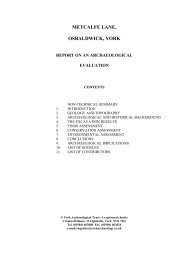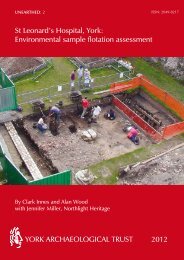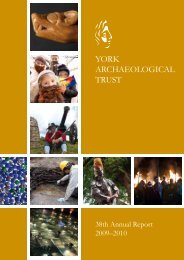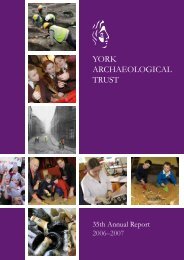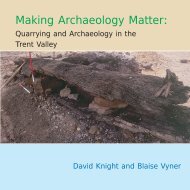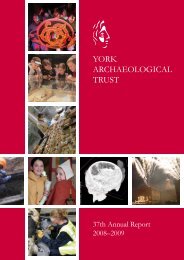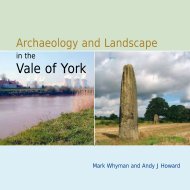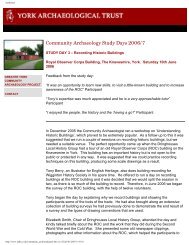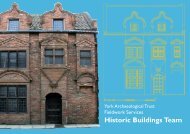- Page 2 and 3: The Archaeology of YorkVolume 2: Hi
- Page 5: ContentsIntroduction ..............
- Page 8 and 9: 42Historical Sources for York Archa
- Page 12 and 13: 46Historical Sources for York Archa
- Page 15 and 16: York Bridgemasters’ Accounts49Fos
- Page 17 and 18: York Bridgemasters’ Accounts51YCA
- Page 19 and 20: York Bridgemasters’ Accounts53YCA
- Page 21 and 22: York Bridgemasters’ Accounts55YCA
- Page 23 and 24: York Bridgemasters’ Accounts57YCA
- Page 25 and 26: York Bridgemasters’ Accounts59And
- Page 27 and 28: York Bridgemasters’ Accounts61And
- Page 29 and 30: York Bridgemasters’ Accounts63Col
- Page 31 and 32: York Bridgemasters’ Accounts65And
- Page 33 and 34: York Bridgemasters’ Accounts67SUM
- Page 35 and 36: York Bridgemasters’ Accounts69YCA
- Page 37 and 38: York Bridgemasters’ Accounts71And
- Page 39 and 40: York Bridgemasters’ Accounts73YCA
- Page 41 and 42: York Bridgemasters’ Accounts75And
- Page 43 and 44: York Bridgemasters’ Accounts77YCA
- Page 45 and 46: York Bridgemasters’ Accounts79And
- Page 47 and 48: York Bridgemasters’ Accounts81YCA
- Page 50 and 51: 84 Historical Sources for York Arch
- Page 52 and 53: 86 Historical Sources for York Arch
- Page 54 and 55: 88 Historical Sources for York Arch
- Page 56 and 57: 90 Historical Sources for York Arch
- Page 58 and 59: 92 Historical Sources for York Arch
- Page 60 and 61:
94 Historical Sources for York Arch
- Page 62 and 63:
96 Historical Sources for York Arch
- Page 64 and 65:
98 Historical Sources for York Arch
- Page 66 and 67:
100 Historical Sources for York Arc
- Page 68 and 69:
102 Historical Sources for York Arc
- Page 70 and 71:
104 Historical Sources for York Arc
- Page 72 and 73:
106 Historical Sources for York Arc
- Page 74 and 75:
108 Historical Sources for York Arc
- Page 76 and 77:
110 Historical Sources for York Arc
- Page 78 and 79:
112 Historical Sources for York Arc
- Page 80 and 81:
114 Historical Sources for York Arc
- Page 82 and 83:
116 Historical Sources for York Arc
- Page 84 and 85:
118 Historical Sources for York Arc
- Page 86 and 87:
120 Historical Sources for York Arc
- Page 88 and 89:
122 Historical Sources for York Arc
- Page 90 and 91:
124 Historical Sources for York Arc
- Page 92 and 93:
126 Historical Sources for York Arc
- Page 94 and 95:
128 Historical Sources for York Arc
- Page 96 and 97:
130 Historical Sources for York Arc
- Page 98 and 99:
132 Historical Sources for York Arc
- Page 100 and 101:
134 Historical Sources for York Arc
- Page 102 and 103:
136 Historical Sources for York Arc
- Page 104 and 105:
138 Historical Sources for York Arc
- Page 106 and 107:
140 Historical Sources for York Arc
- Page 108 and 109:
142 Historical Sources for York Arc
- Page 110 and 111:
144 Historical Sources for York Arc
- Page 112 and 113:
146 Historical Sources for York Arc
- Page 114 and 115:
148 Historical Sources for York Arc
- Page 116 and 117:
150 Historical Sources for York Arc
- Page 118 and 119:
152 Historical Sources for York Arc
- Page 120 and 121:
154 Historical Sources for York Arc
- Page 122 and 123:
156 Historical Sources for York Arc
- Page 124 and 125:
158 Historical Sources for York Arc
- Page 126 and 127:
160 Historical Sources for York Arc
- Page 128 and 129:
162 Historical Sources for York Arc
- Page 130 and 131:
164 Historical Sources for York Arc
- Page 132 and 133:
166 Historical Sources for York Arc
- Page 134 and 135:
168 Historical Sources for York Arc
- Page 136 and 137:
170 Historical Sources for York Arc
- Page 138 and 139:
172 Historical Sources for York Arc
- Page 140 and 141:
174 Historical Sources for York Arc
- Page 142 and 143:
176 Historical Sources for York Arc
- Page 144 and 145:
178 Historical Sources for York Arc
- Page 146 and 147:
180 Historical Sources for York Arc
- Page 148 and 149:
182 Historical Sources for York Arc
- Page 150 and 151:
184 Historical Sources for York Arc
- Page 152 and 153:
186 Historical Sources for York Arc
- Page 154 and 155:
188 Historical Sources for York Arc
- Page 156 and 157:
190 Historical Sources for York Arc
- Page 158 and 159:
192 Historical Sources for York Arc
- Page 160 and 161:
194 Historical Sources for York Arc
- Page 162 and 163:
196 Historical Sources for York Arc
- Page 164 and 165:
198 Historical Sources for York Arc
- Page 166 and 167:
200 Historical Sources for York Arc
- Page 168 and 169:
202 Historical Sources for York Arc
- Page 170 and 171:
204 Historical Sources for York Arc
- Page 172 and 173:
206 Historical Sources for York Arc
- Page 174 and 175:
208 Historical Sources for York Arc
- Page 176 and 177:
210 Historical Sources for York Arc
- Page 178 and 179:
212 Historical Sources for York Arc
- Page 180 and 181:
214 Historical Sources for York Arc
- Page 182 and 183:
216 Historical Sources for York Arc
- Page 184 and 185:
218 Historical Sources for York Arc
- Page 186 and 187:
220 Historical Sources for York Arc
- Page 188 and 189:
222 Historical Sources for York Arc
- Page 190 and 191:
224 Historical Sources for York Arc
- Page 192 and 193:
226 Historical Sources for York Arc
- Page 194 and 195:
228 Historical Sources for York Arc
- Page 196 and 197:
230 Historical Sources for York Arc
- Page 198 and 199:
232 Historical Sources for York Arc
- Page 200 and 201:
234 Historical Sources for York Arc
- Page 202 and 203:
236 Historical Sources for York Arc
- Page 204 and 205:
238 Historical Sources for York Arc
- Page 206 and 207:
240 Historical Sources for York Arc
- Page 208:
242 Historical Sources for York Arc
- Page 211 and 212:
York Bridgemasters’ Accounts245Li
- Page 213 and 214:
York Bridgemasters’ Accounts247YC
- Page 215 and 216:
York Bridgemasters’ Accounts249An
- Page 217 and 218:
York Bridgemasters’ Accounts251An
- Page 219 and 220:
York Bridgemasters’ Accounts253Do
- Page 221 and 222:
York Bridgemasters’ Accounts255Jo
- Page 223 and 224:
York Bridgemasters’ Accounts257pa
- Page 225 and 226:
York Bridgemasters’ Accounts259YC
- Page 227 and 228:
York Bridgemasters’ Accounts261An
- Page 229 and 230:
York Bridgemasters’ Accounts263An
- Page 231 and 232:
York Bridgemasters’ Accounts265bu
- Page 233 and 234:
York Bridgemasters’ Accounts267YC
- Page 235 and 236:
York Bridgemasters’ Accounts269Pe
- Page 237 and 238:
York Bridgemasters’ Accounts271Pe
- Page 239 and 240:
York Bridgemasters’ Accounts273MI
- Page 241 and 242:
York Bridgemasters’ Accounts275An
- Page 243 and 244:
York Bridgemasters’ Accounts277Pe
- Page 245 and 246:
York Bridgemasters’ Accounts279YC
- Page 247 and 248:
York Bridgemasters’ Accounts281Pe
- Page 249 and 250:
York Bridgemasters’ Accounts283Pe
- Page 251 and 252:
York Bridgemasters’ Accounts285Pe
- Page 253 and 254:
York Bridgemasters’ Accounts287Pe
- Page 255 and 256:
York Bridgemasters’ Accounts289An
- Page 257 and 258:
York Bridgemasters’ Accounts291Pe
- Page 259 and 260:
York Bridgemasters’ Accounts293Th
- Page 261 and 262:
York Bridgemasters’ Accounts295Pe
- Page 263 and 264:
York Bridgemasters’ Accounts297To
- Page 265 and 266:
York Bridgemasters’ Accounts299in
- Page 267 and 268:
York Bridgemasters’ Accounts301To
- Page 269 and 270:
York Bridgemasters’ Accounts303AR
- Page 271 and 272:
York Bridgemasters’ Accounts305An
- Page 273 and 274:
York Bridgemasters’ Accounts307MI
- Page 275 and 276:
York Bridgemasters’ Accounts309YC
- Page 277 and 278:
York Bridgemasters’ Accounts311Pe
- Page 279 and 280:
York Bridgemasters’ Accounts313Pe
- Page 281 and 282:
York Bridgemasters’ Accounts315Pe
- Page 283 and 284:
York Bridgemasters’ Accounts317Pe
- Page 285 and 286:
York Bridgemasters’ Accounts319Pe
- Page 287 and 288:
York Bridgemasters’ Accounts321Pe
- Page 289 and 290:
York Bridgemasters’ Accounts323Pe
- Page 291 and 292:
York Bridgemasters’ Accounts325Pe
- Page 293 and 294:
York Bridgemasters’ Accounts327An
- Page 295 and 296:
York Bridgemasters’ Accounts329te
- Page 297 and 298:
York Bridgemasters’ Accounts331YC
- Page 299 and 300:
York Bridgemasters’ Accounts333Pe
- Page 301 and 302:
York Bridgemasters’ Accounts335Pe
- Page 303 and 304:
York Bridgemasters’ Accounts337Pe
- Page 305 and 306:
York Bridgemasters’ Accounts339Pe
- Page 307 and 308:
York Bridgemasters’ Accounts341Pe
- Page 309 and 310:
York Bridgemasters’ Accounts343Pe
- Page 311 and 312:
York Bridgemasters’ Accounts345Pe
- Page 313 and 314:
York Bridgemasters’ Accounts347An
- Page 315 and 316:
York Bridgemasters’ Accounts349To
- Page 317 and 318:
York Bridgemasters’ Accounts351te
- Page 319 and 320:
York Bridgemasters’ Accounts353Ru
- Page 321 and 322:
York Bridgemasters’ Accounts355fa
- Page 323 and 324:
York Bridgemasters’ Accounts357is
- Page 325 and 326:
York Bridgemasters’ Accounts359Pe
- Page 327 and 328:
York Bridgemasters’ Accounts361To
- Page 329 and 330:
York Bridgemasters’ Accounts363An
- Page 331 and 332:
York Bridgemasters’ Accounts365Pe
- Page 333 and 334:
York Bridgemasters’ Accounts367An
- Page 335 and 336:
York Bridgemasters’ Accounts369Pe
- Page 337 and 338:
York Bridgemasters’ Accounts371Pe
- Page 339 and 340:
York Bridgemasters’ Accounts373An
- Page 341 and 342:
York Bridgemasters’ Accounts375To
- Page 343 and 344:
York Bridgemasters’ Accounts377of
- Page 345 and 346:
York Bridgemasters’ Accounts379se
- Page 347 and 348:
York Bridgemasters’ Accounts381fa
- Page 349 and 350:
York Bridgemasters’ Accounts383An
- Page 351 and 352:
York Bridgemasters’ Accounts385Pe
- Page 353 and 354:
York Bridgemasters’ Accounts387An
- Page 355 and 356:
York Bridgemasters’ Accounts389Pe
- Page 357 and 358:
York Bridgemasters’ Accounts391Pe
- Page 359 and 360:
York Bridgemasters’ Accounts393An
- Page 361 and 362:
York Bridgemasters’ Accounts395Pe
- Page 363 and 364:
York Bridgemasters’ Accounts397An
- Page 365 and 366:
York Bridgemasters’ Accounts399Pe
- Page 367 and 368:
York Bridgemasters’ Accounts401OT
- Page 369 and 370:
York Bridgemasters’ Accounts403da
- Page 371 and 372:
York Bridgemasters’ Accounts405OU
- Page 373 and 374:
York Bridgemasters’ Accounts407Co
- Page 375 and 376:
York Bridgemasters’ Accounts409se
- Page 377 and 378:
York Bridgemasters’ Accounts411Pe
- Page 379 and 380:
York Bridgemasters’ Accounts413Pe
- Page 381 and 382:
York Bridgemasters’ Accounts415Pe
- Page 383 and 384:
York Bridgemasters’ Accounts417Pe
- Page 385 and 386:
York Bridgemasters’ Accounts419YC
- Page 387 and 388:
York Bridgemasters’ Accounts421Pe
- Page 389 and 390:
York Bridgemasters’ Accounts423Pe
- Page 391 and 392:
York Bridgemasters’ Accounts425Pe
- Page 393 and 394:
York Bridgemasters’ Accounts427An
- Page 395 and 396:
York Bridgemasters’ Accounts429Pe
- Page 397 and 398:
York Bridgemasters’ Accounts431An
- Page 399 and 400:
York Bridgemasters’ Accounts433Pe
- Page 401 and 402:
York Bridgemasters’ Accounts435To
- Page 403 and 404:
York Bridgemasters’ Accounts437(C
- Page 405 and 406:
York Bridgemasters’ Accounts439da
- Page 407 and 408:
York Bridgemasters’ Accounts441YC
- Page 409 and 410:
York Bridgemasters’ Accounts443An
- Page 411 and 412:
York Bridgemasters’ Accounts445te
- Page 413 and 414:
York Bridgemasters’ Accounts447fo
- Page 415 and 416:
York Bridgemasters’ Accounts449(F
- Page 417 and 418:
York Bridgemasters’ Accounts451te
- Page 419 and 420:
York Bridgemasters’ Accounts453sh
- Page 421 and 422:
York Bridgemasters’ Accounts455YC
- Page 423 and 424:
York Bridgemasters’ Accounts457Gl
- Page 425 and 426:
York Bridgemasters’ Accounts459Ca
- Page 427 and 428:
York Bridgemasters’ Accounts461Ha
- Page 429 and 430:
York Bridgemasters’ Accounts463Pl
- Page 431 and 432:
York Bridgemasters’ Accounts465St
- Page 433 and 434:
York Bridgemasters’ Accounts467Ap
- Page 435 and 436:
York Bridgemasters’ Accounts46914
- Page 437 and 438:
York Bridgemasters’ Accounts47114
- Page 439 and 440:
York Bridgemasters’ Accounts47313
- Page 441 and 442:
York Bridgemasters’ Accounts47514
- Page 443 and 444:
York Bridgemasters’ Accounts477Ap
- Page 445 and 446:
York Bridgemasters’ Accounts479Bo
- Page 447 and 448:
York Bridgemasters’ Accounts481Ho
- Page 449:
York Bridgemasters’ Accounts483Ta
- Page 453 and 454:
486Historical Sources for York Arch
- Page 455 and 456:
archbishop see Booth, William, Arch
- Page 457 and 458:
Barton—, armiger, 294—, Domina,
- Page 459 and 460:
Boiss, John, 276Bolland (Boland; Bo
- Page 461 and 462:
Bryan see BrianBryg see BrigBrygenh
- Page 463 and 464:
Carter (contd)John, 340, 348, 375Jo
- Page 465 and 466:
church of Holy Trinity (Goodramgate
- Page 467 and 468:
Colstane (Colstan; Colstaune; Colst
- Page 469 and 470:
Crosby (Crossby; Crosseby) (contd)J
- Page 471 and 472:
Ebor, Richard, 151Ecopp, Robert, br
- Page 473 and 474:
Fishlake, John, candeler and warden
- Page 475 and 476:
gardens (contd)Havergate, 121Holgat
- Page 477 and 478:
Grayson (Greyson)John, 445, 454Thom
- Page 479 and 480:
Hawslyn see HauslynHaxay see HaxeyH
- Page 481 and 482:
Holtby (Holteby)John, skinner, 56,
- Page 483 and 484:
John of Beverley, St, chantry, 296,
- Page 485 and 486:
Lam (Lambe; Lame)Andrew, wife of, 4
- Page 487 and 488:
Lygeard, Richard, ironmonger and wa
- Page 489 and 490:
Micklegate, rents (contd)3; 1440: 1
- Page 491 and 492:
North Street (contd)rents1400: 122,
- Page 493 and 494:
Peasholmechaplain of, 447passage, 2
- Page 495 and 496:
prison see kydcotetePristonAlice, 2
- Page 497 and 498:
Rudd (Rudde), John, 367, 409, 429,
- Page 499 and 500:
servants, people described as, 205,
- Page 501 and 502:
Spen Lane see SpynlaneSpence (Spens
- Page 503 and 504:
Swynton—, 55Agnes, 58, 75, 219, 2
- Page 505 and 506:
Toftes, rents (contd)1444: 232-4; 1
- Page 507 and 508:
Waleys, Robert, 263WalkerAgnes, 240
- Page 509 and 510:
White Friars Gate, 453White (Whyte)
- Page 511:
The Archaeology of YorkGeneral Edit



